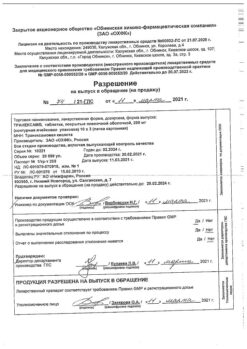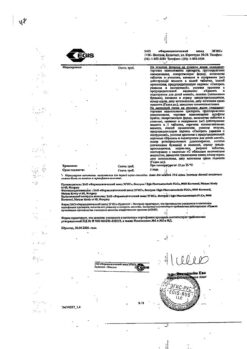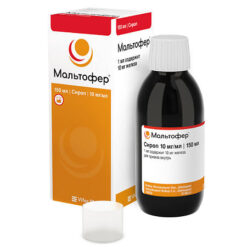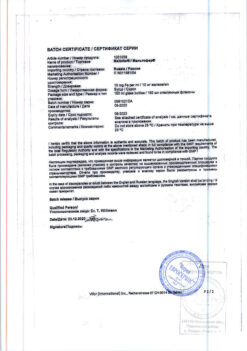No products in the cart.
Tranexamic acid, 50 mg/ml 5 ml 5 pcs
€1.00
Out of stock
(E-mail when Stock is available)
Description
Pharmacotherapeutic group: hemostatic agent.
ATX code: B02AA02.
Pharmacological properties
Pharmacodynamics
Antifibrinolytic agent, is a competitive (at high
concentrations – non-competitive) inhibitor of plasminogen activation and
its conversion to plasmin. It has local and systemic hemostatic action in bleeding associated with increased fibrinolysis (platelet pathology, menorrhagia). By suppressing the formation of kinins and other active peptides involved in allergic and 2 inflammatory reactions it has anti-allergic, anti-inflammatory, anti-infectious and anti-tumor action. In experimental studies the intrinsic analgesic activity of tranexamic acid as well as the potentiating effect in relation to the analgesic activity of opioid analgesics has been confirmed.
Tranexamic acid at a concentration of 1 mg/ml does not aggregate platelets in vitro and at concentrations up to 10 mg/ml has no effect on platelet count, clotting time or various clotting factors in whole blood or nitrate blood in a healthy person. On the other hand, tranexamic acid at both 1 mg/ml and 10 mg/ml blood concentrations prolongs thrombin time.
Pharmacokinetics
The distribution in tissues is relatively uniform (except in cerebrospinal fluid, where the concentration is 1/10 of plasma). It penetrates the placental barrier (the concentration in umbilical cord blood after administration to a woman at a dose of 10 mg/kg can be quite high, about 30 µg/ml fetal serum) and the blood-brain barrier (BBB), is excreted with breast milk (reaching about 1% of the concentration in maternal plasma). It is found in seminal fluid, where it reduces fibrinolytic activity, but does not affect sperm migration. Tranexamic acid rapidly diffuses into the joint fluid and through the synovial membranes; it is found in the joint fluid at the same concentration as in blood serum. The biological half-life from joint fluid is about 3 hours.
The initial volume of distribution (Vd) is 9-12 liters.
The binding to plasma proteins (profibrinolysin) is less than 3%.
In the blood about 3% is bound to protein (plasminogen). Total renal
clearance is equal to plasma clearance.
The antifibrinolytic concentration in various tissues persists for 17 h. In plasma – up to 7-8 h.
It is metabolized to a small extent. The area under the curve “concentration/time” (AUC) has a three-phase shape with a half-life (T1/2) in the terminal phase – 2 hours. Total renal clearance is equal to plasma clearance (7 l/h). Two metabolites of tranexamic acid have been identified: N-acetylated and deaminated derivatives.
It is excreted by the kidneys (the main route is glomerular filtration), more than 95% in
unchanged during the first 12 h. After intravenous administration at a dose of 10 mg/kg, approximately 90% of tranexamic acid is eliminated by glomerular filtration within 24 hours.
Pharmacokinetics in special clinical cases
In impaired renal function there is a risk of cumulation of tranexamic acid
.
Indications
Indications
Prevention and treatment of bleeding due to generalized or localized fibrinolysis in adults and children 1 year and older, including:
– menorrhagia and metrorrhagia;
– gastrointestinal bleeding;
– bleeding after prostate and urinary tract surgery;
– bleeding after surgical interventions in the cavity of the nose, mouth, and pharynx (adenoidectomy, tonsillectomy, tooth extraction);
– bleeding after thoracic, abdominal, and other major surgical interventions (including cardiac surgery.
– obstetric and gynecological bleeding (including bleeding during gynecological surgical interventions);
– bleeding caused by the use of fibrinolytic drugs.
Active ingredient
Active ingredient
Composition
Composition
Active ingredient: tranexamic acid 50 mg.
Excipients: water for injection up to 1 ml.
How to take, the dosage
How to take, the dosage
Intravenously by drip or stream slowly; infusion rate 1 ml/min
(50 mg/min). Rapid intravenous administration should be avoided!
Adult patients
The treatment of menorrhagia and metrorrhagia, gastrointestinal bleeding:
500 mg (2 ampoules of 5 ml) 2-3 times a day from the onset of bleeding until it stops.
Treatment of bleeding after surgical interventions on the prostate and urinary tract: 1000 mg (4 ampoules of 5 ml) 3 times a day from the time of bleeding until it stops.
Prevention and treatment of bleeding during surgical interventions in the nasal cavity and pharynx: 10-15 mg/ml body weight every 6-8 hours until bleeding stops.
The prevention and treatment of bleeding during thoracic, abdominal and other major surgical interventions: 15 mg/kg body weight every 6-8 hours until bleeding stops.
Prevention and treatment of bleeding during cardiac surgery:
A loading dose of 15 mg/kg after induction of anesthesia before surgical intervention, followed by intravenous infusion at a rate of 4.5 mg/kg/hr throughout surgery; tranexamic acid at a dose of 0.6 mg/kg on the ventilator is recommended.
The treatment of obstetric and gynecologic bleeding (including bleeding during gynecologic surgical interventions): 15 mg/kg body weight every 6-8 hours from the onset of bleeding until it stops.
The treatment of bleeding caused by the use of fibrinolytic drugs: 10 mg/kg body weight every 6-8 hours from the time the bleeding develops until it stops.
If prolonged (more than 48 hours) hemostatic therapy is necessary, the use of tranexamic acid preparations in tablet form is recommended.
Children over 1 year
The experience with tranexamic acid preparation is limited.
The recommended dose of the drug in the treatment of bleeding caused by local and generalized fibrinolysis is 20 mg/kg/day. The use of the drug in special patient groups
Patients with impaired renal function
In patients with mild to moderate impaired renal excretory function the dose and frequency of administration of tranexamic acid must be adjusted (See Table 1. Table 1).
Table 1. Dosing regimen correction
Creatinine concentration
serum concentration
The glomerular filtration rate (GFR)
Dose
of tranexamic acid
Frequency of administration
120 – 249 µmol/L
(1.36-2.82 mg/dL)
/p>
60-89 ml/min/1.73 m2
15 mg/kg body weight
2 times a day
250 – 500 μmol/l
(2.83-5.66 mg/dL)
30-59 ml/min/1.73 m2
15 mg/kg body weight
1 time per day
Hepatic impairment
Dose adjustment is not required in patients with hepatic impairment. Elderly patients
Dose adjustment is not required in elderly patients in the absence of renal impairment.
Interaction
Interaction
Tranexamic acid has not been specifically studied in clinical studies on interactions with other drugs.
Tranexamic acid interferes with the pharmacological effect of fibrinolytic (thrombolytic) drugs.
The combined oral contraceptives increase the risk of venous thromboembolic complications and arterial thrombosis (particularly ischemic stroke and myocardial infarction). There is no experience with tranexamic acid in women taking combined oral contraceptives. Since tranexamic acid has an antifibrinolytic effect, concomitant use with combined, oral contraceptives may lead to an additional increased risk of thrombotic complications.
The concomitant use of tranexamic acid with preparations of clotting factors II, VII, IX and X in combination (prothrombin complex) or anti-inhibitor coagulant complex increases the risk of thrombosis.
The risk of thrombotic complications (particularly myocardial infarction) may be increased with concomitant use of tranexamic acid with hydrochlorothiazide, desmopressin, ampicillin-sulbactam, ranitidine and nitroglycerin.
Concomitant use with hemostatic drugs may activate thrombosis.
The concomitant use of tranexamic acid with anticoagulants should be under close medical supervision (experience of use is limited). Pharmaceutical drug interactions
Tranexamic acid solution is compatible with most infusion solutions (0.9% sodium chloride solution, Ringer’s solution, 5% dextrose solution, amino acid solutions, dextrans).
The tranexamic acid solution is compatible with unfractionated heparin.
Tranexamic acid solution is pharmaceutically incompatible with urokinase, norepinephrine, dipyridamole, diazepam.
Tranexamic acid solution should not be mixed with antibiotic solutions (penicillins, tetracyclines) and blood products.
Special Instructions
Special Instructions
Before and during treatment with the drug, an ophthalmologist should be examined for visual acuity, color perception, ocular fundus condition. If visual disturbances occur against the background of therapy, the drug should be withdrawn.
Tranexamic acid should be used with caution in hematuria caused by diseases of the renal parenchyma, because in these conditions there is often intravascular deposition of fibrin, which may aggravate renal damage. In addition, in cases of massive bleeding of any etiology from the upper urinary tract, antifibrinolytic therapy increases the risk of blood clot formation in the renal pelvis and/or ureter and, accordingly, secondary mechanical obstruction of the urinary tract and development of anuria.
While clinical studies have shown no significant increase in the incidence of thrombosis, however, the risk of thrombotic complications cannot be completely excluded. Cases of venous and arterial thrombosis and thromboembolism have been described in patients treated with tranexamic acid. In addition, cases of central retinal artery occlusion and central retinal vein occlusion have been reported. Several patients developed intracranial thrombosis during treatment with tranexamic acid. Accordingly, in patients with a high risk of thrombosis (history of thromboembolic complications, cases of thromboembolism in relatives, verified diagnosis of thrombophilia) tranexamic acid should be used only if absolutely necessary and under strict medical supervision. Prior to the use of tranexamic acid, an examination should be performed to identify risk factors for thromboembolic complications.
In patients with renal insufficiency, the concentration of tranexamic acid in the blood is increased, so in these cases, it is recommended to reduce the dose of the drug.
The presence of blood in cavities such as the pleural cavity, joint cavities, and urinary tract (including renal pelvis and bladder) can lead to the formation of an “insoluble clot” due to extravascular clotting, which may be resistant to physiological fibrinolysis.
Patients with irregular menstrual bleeding should not be prescribed tranexamic acid until the cause of dysmenorrhea has been determined. If menstrual bleeding volume is inadequately reduced on the tranexamic acid treatment background, alternative treatment should be considered.
The efficacy and safety of tranexamic acid preparations in the treatment of menorrhagia in patients under 16 years of age have not been established.
Tranexamic acid should be used with caution in women concomitantly taking combined oral contraceptives because of the increased risk of thrombosis (See section “Interaction with other medicinal products”).
Patients with DICT who require treatment with tranexamic acid should be under the close supervision of a physician experienced in the treatment of this condition.
In the absence of adequate clinical studies, concomitant use of tranexamic acid with anticoagulants should be under the close supervision of a physician experienced in the treatment of clotting disorders.
Influence on the ability to drive vehicles and mechanisms
Synopsis
Synopsis
Contraindications
Contraindications
– hypersensitivity to tranexamic acid;
– severe chronic renal failure (glomerular filtration rate [GFR] less than 30 mg/mL/173 m2) due to the risk of cumulation;
– current or history of venous or arterial thrombosis (deep vein thrombosis of the lower extremities, pulmonary thromboembolism, intracranial thrombosis, etc.).) when simultaneous anticoagulant therapy is possible;
– fibrinolysis due to consumption coagulopathy (hypoagulable stage of disseminated intravascular coagulation syndrome [DIC]);
– history of convulsions;
– acquired color vision impairment;
– subarachnoid hemorrhage (due to risk of cerebral edema, ischemia, and cerebral infarction);
– treatment of menorrhagia in patients under the age of 16 (no experience with
).
– childhood under 1 year of age (no experience of use).
Cautions
Tranexamic acid should be used with caution in the following situations:
– hematuria caused by diseases of the renal parenchyma and bleeding from the upper urinary tract (risk of secondary mechanical obstruction of the urinary tract by a blood clot with the development of anuria), (See
Patients at high risk of thrombosis (history of thromboembolic events or family history of thromboembolic disease, verified diagnosis of thrombophilia);
– disseminated intravascular coagulation syndrome (DIC);
– presence of blood in cavities, such as in the pleural cavity, joint cavities, and urinary tract;
Patients receiving anticoagulant therapy (experience with limited use);
– concomitant use of blood clotting factors II, VII, IX and X in combination (prothrombin complex) or anti-inhibitor coagulant complex (See “Interaction with Other Agents”).
Side effects
Side effects
The frequency of adverse reactions is distributed in the following order:
very often (>1/10), often (1â¥100 to < 1/10), not often (â¥1/1000 to < 1/100), frequently (â¥1/10,000 to < 1/1000), very rarely (< 1/10,000), including reports of single cases.
immune system disorders:
very rare: hypersensitivity reactions, including anaphylactic shock.
Nervous system disorders:
rarely: dizziness; seizures (usually when administered intravenously).
Visual disorders:
frequently:visual disturbances, including color perception, retinal vascular thrombosis.
vascular disorders:
rarely: thromboembolic complications, marked decrease in BP (usually due to excessively rapid intravenous administration, exceptionally after ingestion);
very rarely: arterial and venous thrombosis of various localization;
frequency unknown: acute myocardial infarction, cerebral artery thrombosis, carotid artery thrombosis, stroke, deep vein thrombosis, pulmonary embolism, renal artery thrombosis with development of cortical necrosis and acute renal failure, aortocoronary shunt occlusion, central artery and retinal vein thrombosis.
Gastrointestinal tract disorders:
often: nausea, vomiting, diarrhea (symptoms subside with dose reduction).
Skin and subcutaneous tissue disorders:
Overdose
Overdose
There are limited data on cases of overdose. One case of overdose has been reported (ingestion of 37 g tranexamic acid). Symptoms:Dizziness, headache, nausea, vomiting, diarrhea; orthostatic symptoms (including dizziness, when moving from horizontal to vertical position), orthostatic arterial hypotension.
Predisposed patients have an increased risk of thrombosis.
Pregnancy use
Pregnancy use
In preclinical studies tranexamic acid had no teratogenic effects. Adequate and strictly controlled efficacy and safety of tranexamic acid preparations in pregnant women have not been conducted. Tranexamic acid penetrates the placental barrier and is detected in umbilical cord blood at concentrations close to maternal.
Because reproductive studies in animals do not always predict reactions in humans, tranexamic acid should only be used during pregnancy if absolutely necessary. Tranexamic acid penetrates into breast milk (the drug concentration in milk is about 1% of the concentration in maternal blood plasma). The development of an antifibrinolytic effect in the infant is unlikely. Nevertheless, caution should be exercised when using tranexamic acid in breastfeeding mothers.
Similarities
Similarities
Additional information
| Shelf life | 3 years. Do not use after the expiration date. |
|---|---|
| Conditions of storage | Temperature not exceeding 25 ° CStore out of reach of children. |
| Manufacturer | Vifitech, Russia |
| Medication form | solution |
| Brand | Vifitech |
Other forms…
Related products
Buy Tranexamic acid, 50 mg/ml 5 ml 5 pcs with delivery to USA, UK, Europe and over 120 other countries.


















